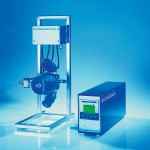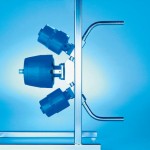Diaphragm pumps are used for hygienic and sterile applications. Their construction and control elements have several weak points, notably concerning in-line sterilisation, dosing precision and automation. The design of the Kobio pump eliminates the major disadvantages of conventional diaphragm types and its controller provides a wide variety of functionalities.
Karin Koller
In most cases pumps are responsible for controlled liquid transfer. As with any other components, the process needs to be fully defined prior to selecting the most suitable pump for the particular environment. Peristaltic and diaphragm pumps are commonly used for hygienic and sterile applications. Peristaltic pumps are easy to handle and transport even the most shear-sensitive liquids gently, but they cannot be employed to transport against a back pressure, for example in fermentation processes with high aeration rates or pressure overlay. Although easy to clean, they cannot be integrated into a CIP (cleaning in place) system. Since the tubing of peristaltic pumps is not allowed to be pressurised, the system cannot be in situ sterilised and therefore full integration into the plant is impossible. The tubing must be autoclaved separately before the process begins and connected in a sterile way after the plant has been sterilised.
Diaphragm pumps can be connected to the piping of the plant to ensure full integration into the process. Most conventional dia-phragm pumps consist of two chambers located opposite each other. They are opened and closed with diaphragms. The two diaphragms are connected by a piston in such a way that each piston stroke opens one chamber and closes the other. Liquid is sucked into the opening chamber with every stroke and dispensed from the closing chamber. In pumps for hygienic applications the diaphragm movement is effected pneumatically. This pump principle leads to a backflow of the transported liquid, which is avoided with check valves at the pump inlet and outlet. The outcome is a reliable and stable flow that overcomes the specified back pressure.
Design problems
The conventional design of diaphragm pumps has disadvantages for sterile applications. Since the diaphragms are interlinked, it is not possible to fully open both pump chambers at the same time. This prevents draining and renders the pump self-priming, but the cleaning process and in-line sterilisation can no longer be conducted safely in accordance with hygienic standards. A pump chamber that is only partially opened cannot be completely rinsed by a cleaning solution or sterilised by steam in the SIP (sterilisation in place) process. This problem is minimised if the pump itself is used to transport the cleaning solutions and both chambers open alternately during the process. If this is not the case, hard-to-clean areas are invariably created, leading to contamination or stuck diaphragms. The latter influence the quality of the pump performance and reduce the service life of the diaphragms. The former endangers the entire process. If the diaphragm position is not exactly defined, there is also a danger of vacuum formation after sterilisation.
Many engineers try to avoid spring-operated check valves in the piping because media residues can remain in the spring even after the CIP process, creating a further source of contamination. In addition, these residues can form encrustations during sterilisation. The alternative would be ball valves, but if particles become stuck inside them, they are liable to leak. Check valves thus represent a higher sterility and operational risk than diaphragm valves.
Diaphragm pumps are used not only for continuous liquid transport but also for controlled on-demand dosing, for instance for pH and anti-foam control. The flow rate of the pump must be adjustable for these applications. In the pumps described above the maximum flow rate is restricted by reducing the valve air pressure, shortening the stroke length or inserting a dosing valve in the discharge line. The first two methods tend to compromise dosing accuracy at low flow rates. An additional valve could signify yet another source of contamination.
Problem solver
To eliminate the problems associated with many diaphragm pumps for hygienic applications, Bioengineering came up with a special design concept for its Kobio pump. This pump comprises three pneumatic diaphragm valves arranged in series. The valves are operated in a controller-defined sequence, which is adjusted to the transported liquid and the application. Suction is achieved by subsequently opening the inlet and dosing valves. The fluid is discharged by closing the inlet valve and opening the outlet valve. A backflow of the liquid is prevented by the opening and closing sequence of the three diaphragm valves. Check valves can hence be dispensed with. The Kobio pump was designed using exclusively pneumatically controlled diaphragm valves. Depending on the application, both the valves and the diaphragms are available in different materials to suit the liquids being transported. Bioengineering’s valves have already proved to be reliable and efficient in other areas of the plant, such as in sterile crosses. The valve geometry, the materials used and the surface properties of the areas in contact with the product are therefore suitable for sterile operation and optimally adapted for applications in the biotech and pharmaceutical industries. The valves have no crevices where media residues could accumulate; they are fully drainable and free of dead legs. Any maintenance work is facilitated by the easy replacement of the diaphragms. Owing to the absence of check valves, the pipes can be easily drained by reversing the flow direction. The ensuing CIP process and sterilisation are effected by selecting a special function on the controller that opens all three valves. The cleaning agent and steam flow through the fully opened valves, so that the contamination risk is minimised and the formation of vacuum in the cooling phase of sterilisation prevented.
Control functions
Since the Kobio pump is not merely actuated but also controlled via an intelligent front module, a variety of control functions are integrated. Flow rate calibration is provided as standard along with the display of the current flow rate and the total transported process volume. The Kobio pump can also be connected in a cascade with another controller. This is an advantage, amongst other things, for the additional pO2 control in cell cultures where media dosage is a function of the gas supply. External control of the Kobio pump is possible using an analogue/digital interface or Profibus. The flow rate of the Kobio pump is controlled by means of pulse intervals. Some applications such as pH control require very high or very low flow rates during the course of the process. The Kobio pump offers a pulse modulation function for this purpose. This allows the pulse length to reduce in a precisely defined way in order to generate very low flow rates – or in extreme cases dose individual drops. The resulting control system reacts to changes in the controlled parameter quickly, flexibly and precisely.
The design of the Kobio pump is simple and concise because only three diaphragm valves approved for sterile applications are used. This minimises the risks and enables in-line sterilisation. At the same time, the pulse sequence in combination with pulse modulation ensures a wide spectrum of precisely defined flow rates. Controlled by an intelligent front module, the Kobio pump is more than just a machine for liquid transport; it is a multifunctional system that can be used to control a variety of loops and that integrates fully into automated plants.
cpp 455
Bioengineering Products
Kobio pump
Share:








